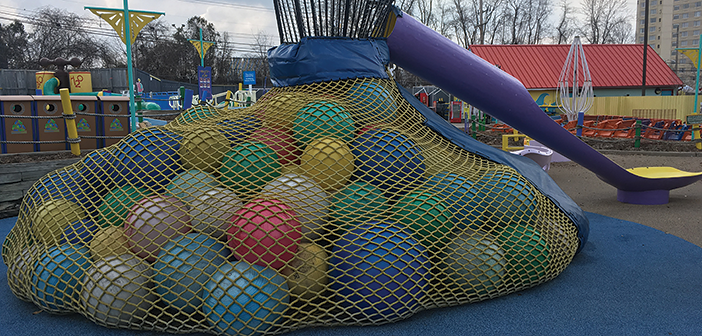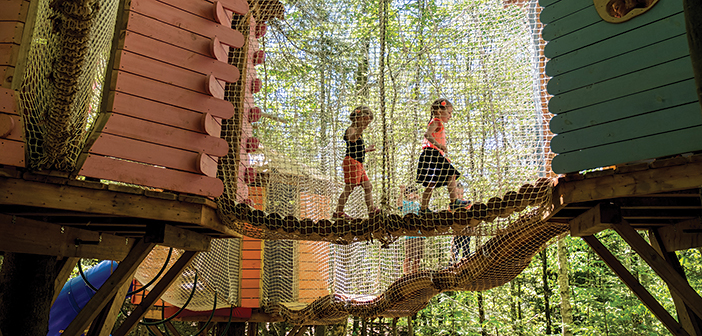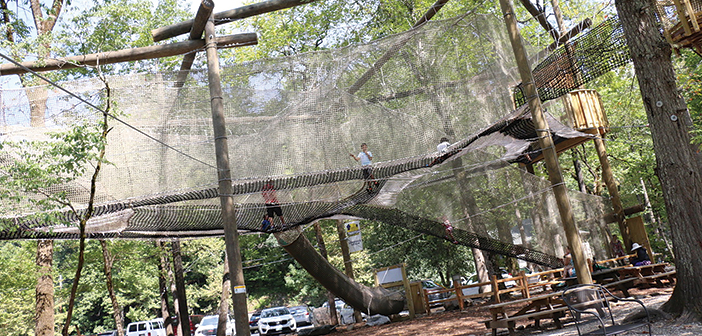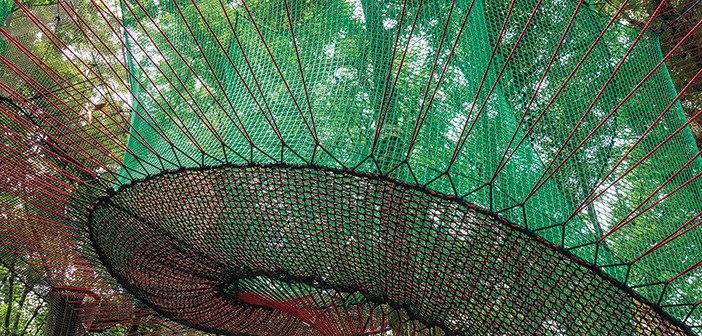Netting is having a moment. High-throughput, belay-free, net-based aerial adventures are popping up all over North America. The material has long been utilized in traditional aerial adventures for safety nets and obstacles like cargo climbing nets and V-net bridges. Now, netting is stepping into the spotlight as the star element of many aerial installations.
These unharnessed activities have several important benefits: They open up the world of aerial adventures to a younger (and older) demographic, are highly customizable, can handle large groups, and have few associated staffing costs. All that makes netted activities an appealing add-on to an existing operation.
WHAT’S OUT THERE?
According to Robin Ritz of net supplier Incord, the trend she sees coming out of France and French Canada is the fully netted adventure system. No harnesses, belays, or lifelines necessary—netting serves as both the safety and challenge elements. “That’s the trend where netting is being hyper-utilized,” she says.
Greg Allen, director of design and installation for Challenge Towers Aerial Adventures, says the designs can take many forms. “Our first build was modeled after a pirate ship, with a crow’s nest that was mounted outside the ship with a net-covered bridge to gain access,” says Allen. The company’s Skynet Play System is a fully enclosed, netted space that can feature net bridges, net tunnels, and multiple rooms and platforms.
Pucuda Leading Edge, a netting supplier and product developer, is working on a multi-story, indoor-outdoor netted ropes course that will utilize its shrinking core nets—a soft catch, low impact trampoline net—instead of harnesses and belays. Founder and owner John Rexroad debuted the design at IAAPA in November.

Pucuda netted ball feature.
Treetop Quest has also developed several types of fully netted systems: an obstacle-free net trampoline for amped up versions of games like dodge ball; Spider Quest, a non-linear obstacle/challenge course with a giant safety net underneath; and the Hobbit Village, also built above a giant safety net, with tree houses and net bridges for bouncing and exploring.
BRIDGE AND PLATFORM MODEL
Designers and builders are appropriating the bridge and platform model used in traditional canopy walks for kid-friendly aerial adventures that are more playful and interactive.
For example, Treetop Trekking’s Treewalk Village is a fenced-in area that centers on a network of brightly colored tree houses connected by net walkways, ramps and slides. Mike Stiell, Ontario marketing director for Treetop Trekking, says Villagers need no harness or belay system, because “anytime visitors are off the ground, they are enclosed in netting,” making the activity easy to operate and easy to access.

Children play on Treetop Quest’s trampoline.
Another notable example: Tree-Mendous won the 2017 New York City “Annual Award for Excellence in Design” for the Nature Trek at the Bronx Zoo. This net-based installation has themed structures such as a tree house, a net platform, and a jungle house, all connected by a series of bridges. “Each bridge is different,” says Tree-Mendous CEO Gerhard Komenda. “And they are a little bit challenging—you have to actually duck and climb a little.” The trek even includes a harness-free zip line through a netted chute.
The attraction welcomed more than 500,000 visitors in its first year of operation, a credit to its family appeal. “Grandma and grandpa can go with the grandkid that is four years old and have a blast in there,” Komenda says. That helps explain why 30 percent of all zoo visitors opted for the $6 trek during their visit.

Treetop Trekking’s Arbraska.
Other Tree-Mendous nature treks include the Squirrel’s Nest—a fully enclosed, netted area where kids can run, bounce, and roll—usually located in unused space between bridges and platforms. Komenda says kids will spend upwards of 45 minutes in the netted nest, jumping around, playing or even just laying back and looking up at the trees. “It’s a very dreamy thing,” he says.
WHY NETTING?
Broad audience. Net-based aerial adventures have largely been designed to serve young kids who are excluded from other aerial attractions due to age, weight, and other equipment-use restrictions. Eliminating the need for harness and belay broadens the range of access. “From a design standpoint,” says Ritz, “the objective is to get ages 2 to 99.”
Communal experience. Netted attractions also offer guests a more communal experience than traditional ropes courses. Treetop Quest development manager Julien Hatton says, “When you do the net course, you share things together because you do them together. It’s not linear. It’s more like a maze. With a belay system activity, you’re stuck to the cable.”

Exploring features at Tree-Mendous‘ Nature Trek.
Freedom to explore. On the flip side, for the more independently minded, a netted attraction offers a guest “the absolute freedom to explore at one’s will,” says Allen.
Pucuda’s Rexroad also thinks freedom from the belay will create an added thrill for guests. However, he stresses that builders and designers looking to create challenge courses free of lifelines need to be careful to avoid fall hazards and use regulation-compliant nets.
Design versatility. Netted attractions have universal design potential. Certain types of netted attractions can be made ADA compliant, like the Nature Trek at the Bronx Zoo, which has split levels and an ADA accessible route. And operators see a lot of possibilities for net systems to cater to kids with disabilities. Stiell of Treetop Trekking notes that net-based attractions make “a great activity for guests with special needs who may not be able to manipulate a traditional belay system.” Allen envisions netted installations being used “as a therapeutic tool.”

Pucuda netting features.
High throughput, immediate access. Perhaps the most significant advantage net systems have over belay systems is high throughput. Some netted attractions can accommodate as many as a 100 guests at one time, and guests can get into the attraction quickly. “It takes too long to put 150 people in the trees at the same time with a belay system,” says Hatton. But with a gear-free netted attraction, guests can start climbing right away; there’s no need for lengthy ground schools and gear-ups.
Treetop Quest deals with a lot of large school groups, and Hatton believes fully enclosed netted attractions improve the guest experience for them. “People don’t need to queue for two hours [while they wait for your ropes course]—they can start with your net course,” he says.
Easier staffing. Additionally, Komenda notes, “If you have a netted course, you don’t need specialized staff. It gives you more flexibility.” An attraction that can be run without specialized staff reduces operating costs. And many operators note that their netted systems can be run at ultra lean ratios—one staffer to 60 guests, for example.

Treetop Trekking’s Stouffville (Ont.) Treetop Village.
Quick ROI. High customer throughput and low operating costs equal a quick return on investment for many operators. The way Hatton sees it, Treetop Quest’s net course starts at $90,000, and it can serve 10,000 to 15,000 people a year. Depending on the admission fee, operators could see a return on investment in the first year.
Customer satisfaction. Another perk? Because you aren’t working with harnesses and belays, “it doesn’t cost you more to let kids go twice,” says Komenda, which has resulted in many thrilled repeat customers at the Bronx Zoo Nature Trek.
BEFORE YOU SAY BYE TO THE BELAY…
As with any aerial adventure, netted installations come with their own set of challenges.
Complex installation. While Hatton says that Treetop Quest’s netted structures are designed to be more compact and condensed, a lot of operators agree that netted enclosures can be more complicated to install than traditional ropes courses.
Allen notes, “Working with these structures takes a very large design and installation effort, and may cost more when compared to the modern aerial course.”
Different regulations. There are also a whole set of different standards to become educated in, beyond the current ACCT and/or ASTM pieces that a company may need to pay attention to, depending upon its location and client base.
Ritz cautions that builders should be careful to “make sure you are using the right material for the appropriate application, understand how critical the attachment is, and consider UV stabilization and durability” when sourcing nets.

Challenge Towers netting feature.
Rexroad, who, in addition to owning Pucuda, chairs ASTM Committee F24, the body that establishes standards and regulations for amusement rides and devices, encourages people to get informed about safety standards. “Do due diligence,” he says, “and make sure you have that understanding of the product and that you are actually getting products that comply with the regulations and standards.”
Lack of familiarity. “There are some very specific differences when designing around an enclosed net system in terms of safety,” says Allen. Some things to be mindful of are fall hazards—such as exposed steel, wood, cable or support structures—the natural movement of the nets, especially if you have stacked spaces, and having a plan to deal with critical emergencies inside the enclosure. “In the end,” Allen says, “it takes a huge amount of R&D and design to suss all this out.”
These types of builds require the knowledge of an experienced engineer. As Rexroad points out, working with a skilled engineer is not only important for designing a safe attraction, but will also pay off on the back end with a longer-lasting product and fewer insurance claims. “I want people to have zero injuries,” he says.
Dealing with trees. Komenda notes that if you are working directly with trees instead of poles, as he prefers to do, that can present some unique engineering challenges as well. “There is no chart to tell you how much this tree holds,” he says, which is why Komenda has been working with the same engineer since he started. They have accumulated data sets to support their tree work.

An adult navigates the ropes course at Stouffville.
Higher environmental impacts. For the eco-conscious, there is another aspect to consider. According to Komenda, netted systems have higher environmental impacts than traditional challenge courses. Net courses often require a lot of bracing and side loading and an extra level of cribbing that ropes courses do not, which means more individually impacted trees. Still, Komenda, who has a background in forestry, says installing any type of tree-based activity instead of logging a forest or splitting it up for development can be a boon for tree conservation.
LOOKING TO THE FUTURE
Netted aerial adventures seem ripe for growth. While there is definite concern about regulations and standards from some builders and suppliers, there is also a lot of enthusiasm for the way netted attractions can bridge the age and accessibility gap in the aerial adventure industry.
A critical link. “These types of installations are really a link,” says Komenda, citing as an example the nature trek Tree-Mendous recently installed at Berkshire East Mountain Resort, Mass. The Berkshire East Tree House Trail is a toned-down, preschooler-accessible alternative to the resort’s adrenaline-inducing bike park, zip line, and ropes course. The nature treks are “wiggly and jiggly,” says Komenda, “but not scary,” making them a solution not only for the kid who isn’t big enough for the other activities, but also for the kid who is a bit apprehensive about high-octane adventures but still wants in on the fun.
Point of differentiation. As the North American adventure market continues to get more competitive, kid-friendly netted installations can help a company stand out. Hatton says Treetop Quest’s fully enclosed net trampoline attractions were developed to help diversify the company’s offerings in a saturated European adventure market, not as a replacement for the traditional challenge course but as “a brand new adventure in the trees.” Netted aerial adventures offer a solution that can help an operator tap into a new demographic, and enhance the guest experience of a park’s existing client base.
NETTING SUPPLIERS
Aerial Adventure Tech www.aerialadventuretech.com
Challenge Towers www.challengetowers.com
Incord www.incord.com
Nets & More www.netsandmore.com
Netstribe www.netstribe.com
Pucuda Leading Edge www.netting.com
Signature Research www.signatureresearch.com
SPS Filets www.spsfilets.com
The Net House www.thenethouse.net
Tree-Mendous www.tree-mendous.com
Treetop Quest www.development.treetopquest.com
Treetop Trekking www.treetoptrekking.com/en/construction



